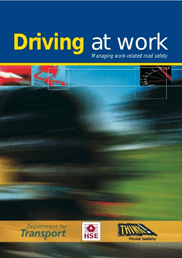Driver Behaviour – does your company have a good road safety culture?
Driver behaviour contributes to most crashes and is often the main cause. Speeding and driving while tired, distracted or under the influence of drugs or alcohol cause many serious crashes.
Employers also have responsibility under Health and Safety legislation to ensure so far as reasonably practicable the health and safety of their employees and others who may be affected by their work activities. This includes the activity of driving on public roads.
If you have employees who drive for work, you need to introduce a road safety culture backed up by good policies, procedures and effective driver training and education, to keep your drivers and the public as safe as possible on the roads.
First, Some facts and figures about Dangerous Driving Behaviour:
Every 1% rise in speed increases the chance of a fatal crash by 4%
To illustrate this let us consider this scenario:
You are driving along in the afternoon and you see up front, a school bus has pulled into a bus stop in the village to let off some school children at the end of the school day. The road ahead is clear, so you decide to overtake the bus, after all you don’t want to be behind that for miles. Just as you draw level with the rear of the bus a schoolchild walks out from in front of it and you hit your brakes.
If you are travelling at 30mph or less, you will stop before hitting the child. BUT if you are going at 31,32, 33mph or faster, you will hit that child and probably kill him/her!!
In 2016, figures show that 230 people were killed and there were over 9,000 casualties in total in drink drive accidents
Although the level of drinking and driving has dropped dramatically over the last three decades, over 200 people are still killed in drink drive accidents every year. Despite 30 years of drink drive education and enforcement, over 70,000 people are still caught drink driving annually.
Often it is an innocent person who suffers, not the driver who is over the drink drive limit. In 2016, 100 pedestrians were killed or seriously injured by drink drivers, as were 390 car passengers. 40 children were killed or seriously injured by drink drivers that year.
In 2017, 325,887 roadside breath tests were carried out by the police, of which 44,893 drivers or riders (14% of those tested) failed or refused to take the test.
Driving whilst dehydrated can be nearly as bad as driving under the influence of alcohol.
Most of us only think about dehydration when it’s hot (if at all), but you can be dehydrated any time of the year if you don’t take on enough liquid. Sure, long journeys on a hot summer’s day will make you more prone to dehydration, but you can be dehydrated because of alcohol consumption the night before, or just generally not drinking enough.
The risks of not drinking enough water can cause
- Dizziness/lightheadedness
- Tiredness
- Headache
These problems can cause drivers to ‘drift’ between lanes, lose concentration and become more prone to making serious mistakes of judgement.
Cannabis and cocaine slow reaction times and distorts perception of time and distance
Impairment by illegal or medical drugs was officially recorded as a contributory factor in 62 fatal road crashes and 259 crashes resulting in serious injuries in 2015 in Britain, but experts estimate the true figure could be much higher.
Interestingly, in 2016 17% of drivers tested for illegal drugs tested positive compared with only 3% in 1980. Unlike alcohol, these drugs take much longer to leave the body. So, if you have a couple of drinks this evening, you should be ok to drive in the morning. BUT if you smoke a joint or take Cocaine, MDMA or any other drug, these will still be affecting your driving for the next few days.
Driving while tired increases the risk of severe crashes due to high speed and lack of avoidance.
How many people do you know that are driving for long journeys, attending intense meetings, working long hours and then driving back again afterwards? These could be sales reps, delivery drivers or even senior management.
If you have such people working for you and you are found to be the cause of their tiredness, and/or you haven’t assessed the risk, then you could be found to be liable.
Perhaps we should consider implementing safety controls similar to those that HGV drivers have to follow, in order to try and reduce the risk of overtired drivers on our roads.
HGV drivers have tachographs in their vehicles and have to follow strict rules such as Maximum Driving Hours:
- The daily maximum driving hours is set to 9 hours but this can be exceeded to 10 hours twice each week.
- The weekly maximum driving hours can total no more than 56 hours.
- The maximum two-weekly driving limit is 90 hours over any two-week period.
They must be given Breaks:
- The driver must take at least 45 minutes of breaks every 4.5 hours of driving unless they take a rest period. This may be a single 45-minute break, or a single 15-minute break followed by a single 30-minute break.
How many people are using their mobile phone in hand or texting whilst driving in the UK
According to the latest 2018 Report on Motoring, released by the RAC, there has been no change in the number of motorists using mobiles behind the wheel in the last twelve months. A full 25% of drivers admit that they have used their phones whilst driving at some point in the last year. 25% of people admit to making or receiving a call when behind the wheel, 39% admit to making or receiving a call whilst the car is stopped but the engine is running. 19% of drivers have checked texts, emails or social media when driving (40% have done so with the car stationery but with the engine running). 16% have actually posted on social media or sent texts or emails whilst driving (33% with the car idling). And 14% of drivers have taken photos whilst driving (22% with the car idling).
What can you, as a responsible employer, do?
Organisations have a legal duty to put in place suitable arrangements to manage health and safety. This is a wide-ranging requirement, so HSE encourages a common-sense and practical approach. It should be part of the everyday process of running an organisation and part of good management generally
Plan – Describe how you manage health and safety in your organisation and plan to make it happen in practice
- Assess the risks from work-related road safety in your organisation.
- Produce a health and safety policy covering, for example, organising journeys, driver training and vehicle maintenance.
- Make sure there is top-level commitment to work-related road safety in your organisation.
- Clearly set out everyone’s roles and responsibilities for work-related road safety. Those responsible should have enough authority to exert influence and be able to communicate effectively to drivers and others.
Do – Prioritise and control your risks, consult your employees and provide training and information
Check – Measure how you are doing
Act – Review your performance and learn from your experience
Assessing risks on the road
As an employer or self-employed person, you are responsible for assessing the risks to health and safety in your business. Risk assessment for any work-related driving activity should follow the same principles as for any other work activity. You can delegate the task, but you will need to make sure it is carried out by someone who:
- is competent to do so (has the right skills, knowledge and experience);
- involves your workers in the process;
- understands when specialist help may be needed.
Identify the hazards
Look for hazards that may result in harm when driving on public roads. Remember to ask your employees, or their representatives, what they think as they will have first-hand experience of what happens in practice.
You need the views of those who drive extensively, but also get the views of those who only use the roads occasionally. The main areas to think about are the driver, the vehicle and the journey.
Who might be harmed?
Decide who might be harmed and how. This will usually be the driver, but it might also include passengers, other road users and/or pedestrians. Also consider whether there are any groups who may be particularly at risk, such as those new to the job and those driving long distances and working long hours.
Evaluate the risks
Having identified the hazards, decide how likely it is that harm will occur. You are not expected to eliminate all risks, but you must make sure you know about the main risks and how to manage them responsibly. You need to do everything reasonably practicable to protect people from harm.
Record your findings
Record your significant findings – make it simple and focus on controls. If you have five or more employees, you are required by law to write it down. If you have fewer than five employees you don’t have to write anything down, but it is good practice to keep a record.
Regularly review your risk assessment
It makes sense to review your risk assessment on a regular basis. There is no set frequency for carrying out a review, but you need to ensure that the risks to those who drive, and others, are suitably controlled.
For this to be effective you need to know about any road incidents, your drivers and vehicle history. Changing circumstances may also prompt a review, eg introducing new routes, new equipment or a change in vehicle specification. If anything significant changes, check your risk assessment and update it.
The Laws that apply
Employers have duties under health and safety law for on-the-road work activities. The Health and Safety at Work etc Act 1974 states you must ensure, so far as reasonably practicable, the health and safety of all employees while at work. You must also ensure that others are not put at risk by your work-related driving activities. The self-employed have similar responsibilities.
‘So far as reasonably practicable’ means balancing the level of risk against the measures needed to control the real risk in terms of money, time or trouble. However, you do not need to take action if it would be grossly disproportionate to the level of risk.
The Management of Health and Safety at Work Regulations 1999 require you to manage health and safety effectively. You must carry out an assessment of the risks to the health and safety of your employees, while they are at work, and to other people who may be affected by your organisation’s work activities.
You must consult with your employees and, where applicable, their health and safety representatives, on health and safety issues, including:
- risks arising from their work;
- proposals to manage and/or control these risks;
- the best ways of providing information and training.
You also have duties under road traffic law, eg the Road Traffic Act and the Road Vehicles (Construction and Use) Regulations, which are administered by the police,and other agencies such as the Driver and Vehicle Standards Agency (DVSA).
In most cases, the police will continue to take the lead on investigating road traffic incidents on public roads. HSE will usually only take enforcement action where the police identify that serious management failures have been a significant contributory factor to the incident.
If one of your employees is killed, for example while driving for work, and there is evidence that serious management failures resulted in a ‘gross breach of a relevant duty of care’, your company or organisation could be at risk of being prosecuted under the Corporate Manslaughter and Corporate Homicide Act 2007.
If you would like any further help or support, please please contact us by phone 01458 253682, email or via our Facebook page or by Twitter.
Taunton & Somerset CPD Group at The Exchange House Taunton
Please remember that we now run these CPD events at the Exchange House, 12 – 14 The Crescent, Taunton TA1 4EB on a fortnightly basis
The next of the CPD events is listed below.
As previously requested, if you could let us know whether or not you can attend it would be greatly appreciated. Also, if you would like to give a talk, or know of somebody who would, please contact Jon at [email protected]
Our next Seminar will be on Wednesday 27th February 2019 Could you please arrive by 12:30 pm prompt.
Our speaker for this one is James Ott of Fakro Roof Windows will talk about Roof Windows In The Modern Design
If you haven’t already booked your place, or if you are not on the CPD Seminar mailing list but would like to be please drop Jon an email and he will deal with your request.
As per our last one if you could let Jon know whether or not you can attend within 7 days of receipt of his email, it would be greatly appreciated.
Contact Details [email protected] 07831 714199 or 01458 253682
*Early notice of 13th March meeting. Ian Dryden of SIG Design & Technology will talk about Roof Refurbishment
For more details about these and the other forthcoming CPD talks please see cpds to 24th April 2019

